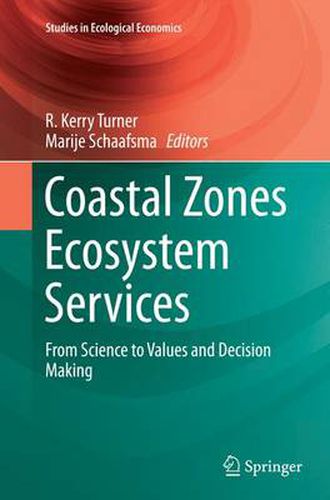Readings Newsletter
Become a Readings Member to make your shopping experience even easier.
Sign in or sign up for free!
You’re not far away from qualifying for FREE standard shipping within Australia
You’ve qualified for FREE standard shipping within Australia
The cart is loading…






This title is printed to order. This book may have been self-published. If so, we cannot guarantee the quality of the content. In the main most books will have gone through the editing process however some may not. We therefore suggest that you be aware of this before ordering this book. If in doubt check either the author or publisher’s details as we are unable to accept any returns unless they are faulty. Please contact us if you have any questions.
This book applies the ‘ecosystem services’ framework to coastal environments, showing how it could facilitate an adaptive management strategy. The contributors describe a decision support system (DSS) based on the 3 Ps - pluralism, pragmatism and precaution - that leads to a more flexible, ‘learn by doing’ approach to the stewardship of coastal environments. The book lays out a Balance Sheets Approach to formatting, interrogating and presenting data and findings. The opening chapter defines coastal zones, their characteristics and natural resources, and describes their complex and dynamic nature. The chapter shows that large-scale trends and pressures have led to a global loss of 50% of marshes, leading to significant declines in biodiversity and habitat. Part I presents a conceptual framework, describes natural science techniques for coastal and shelf modeling, and describes valuation of ecosystem services. Part II outlines practical ecosystem indicators for coastal and marine ecosystem services, reviews literature on valuation of coastal and marine ecosystem services, explores scenarios, outlines marine and coastal ecosystem services data and offers tools for incorporating data into decision-making. PART III offers case studies including one linking the ecosystem services of Marine Protected Areas to benefits in human wellbeing; and another on valuing blue carbon captured by oceans and coastal ecosystems. Also included are a study of managed realignments and the English coastline and their value estimate transferability; and studies of the impact of jellyfish blooms on recreation in the UK and on fisheries in Italy.
$9.00 standard shipping within Australia
FREE standard shipping within Australia for orders over $100.00
Express & International shipping calculated at checkout
This title is printed to order. This book may have been self-published. If so, we cannot guarantee the quality of the content. In the main most books will have gone through the editing process however some may not. We therefore suggest that you be aware of this before ordering this book. If in doubt check either the author or publisher’s details as we are unable to accept any returns unless they are faulty. Please contact us if you have any questions.
This book applies the ‘ecosystem services’ framework to coastal environments, showing how it could facilitate an adaptive management strategy. The contributors describe a decision support system (DSS) based on the 3 Ps - pluralism, pragmatism and precaution - that leads to a more flexible, ‘learn by doing’ approach to the stewardship of coastal environments. The book lays out a Balance Sheets Approach to formatting, interrogating and presenting data and findings. The opening chapter defines coastal zones, their characteristics and natural resources, and describes their complex and dynamic nature. The chapter shows that large-scale trends and pressures have led to a global loss of 50% of marshes, leading to significant declines in biodiversity and habitat. Part I presents a conceptual framework, describes natural science techniques for coastal and shelf modeling, and describes valuation of ecosystem services. Part II outlines practical ecosystem indicators for coastal and marine ecosystem services, reviews literature on valuation of coastal and marine ecosystem services, explores scenarios, outlines marine and coastal ecosystem services data and offers tools for incorporating data into decision-making. PART III offers case studies including one linking the ecosystem services of Marine Protected Areas to benefits in human wellbeing; and another on valuing blue carbon captured by oceans and coastal ecosystems. Also included are a study of managed realignments and the English coastline and their value estimate transferability; and studies of the impact of jellyfish blooms on recreation in the UK and on fisheries in Italy.